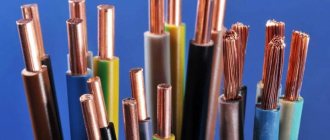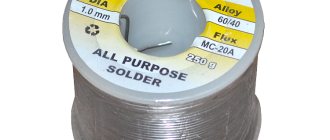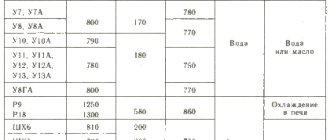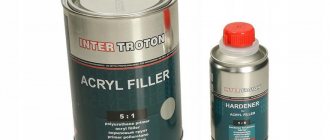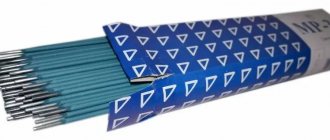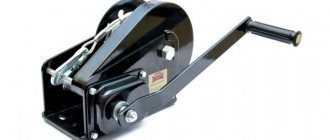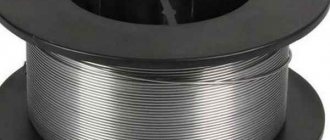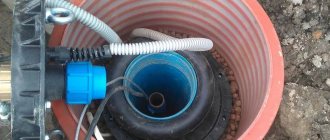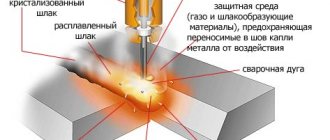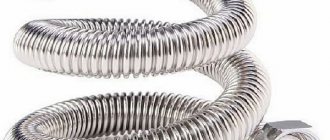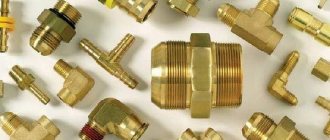Thermal conductivity and density of aluminum
The table shows the thermophysical properties of aluminum Al depending on temperature.
The properties of aluminum are given over a wide temperature range - from minus 223 to 1527 ° C (from 50 to 1800 K). As can be seen from the table, the thermal conductivity of aluminum at room temperature is about 236 W/(m deg), which allows this material to be used for the manufacture of radiators and various heat sinks.
In addition to aluminum, copper also has high thermal conductivity. Which metal has the greater thermal conductivity? It is known that the thermal conductivity of aluminum at medium and high temperatures is still less than that of copper, however, when cooled to 50K, the thermal conductivity of aluminum increases significantly and reaches a value of 1350 W/(m deg). For copper, at such a low temperature, the thermal conductivity value becomes lower than for aluminum and amounts to 1250 W/(m deg).
Aluminum begins to melt at a temperature of 933.61 K (about 660 ° C), while some of its properties undergo significant changes. The values of properties such as thermal diffusivity, aluminum density and thermal conductivity are significantly reduced.
The density of aluminum is mainly determined by its temperature and depends on the state of aggregation of this metal. For example, at a temperature of 27°C, the density of aluminum is 2697 kg/m3, and when this metal is heated to its melting point (660°C), its density becomes equal to 2368 kg/m3. The decrease in aluminum density with increasing temperature is due to its expansion when heated.
Cable cross-section
The cable cross-section is the cut area of the current-carrying core. If the cut of the core is round (as in most cases) and consists of one wire, then the area/section is determined by the formula for the area of a circle. If there are many wires in the core, then the cross-section will be the sum of the cross-sections of all the wires in this core.
The cross-sectional values are standardized in all countries, and the standards of the former CIS and Europe in this part completely coincide. In our country, the document that regulates this issue is the “Rules for the Construction of Electrical Installations” or briefly - PUE.
The cable cross-section is selected based on the loads using special tables called “Permissible current loads on the cable.” If you have no desire to understand these tables, then it is enough for you to know that it is advisable to use a copper cable with a cross-section of 1.5-2.5 mm² for sockets, and 1.0-1.5 mm² for lighting.
To introduce one phase into an ordinary 2-3 room apartment, 6.0 mm² is quite enough. All the same, your 40-80 m² will not fit larger equipment, even taking into account the electric stove.
Many electricians, in order to “estimate” the required cross-section, believe that 1mm² of copper wire can pass 10A of electric current through itself: accordingly, 2.5 mm² of copper can pass 25A, and 4.0 mm² - 40A, etc. If you analyze the cable cross-section selection table a little, you will see that this method is only suitable for estimation and only for cables with a cross-section no higher than 6.0 mm².
Below is an abbreviated table for selecting cable cross-sections up to 35 mm² depending on current loads. For your convenience, the total power of electrical equipment is given there for 1-phase (220V) and 3-phase (380V) consumption.
When laying the cable in a pipe (i.e. in any closed spaces), the possible current loads on the cable should be less than when laying it openly. This is due to the fact that the cable heats up during operation, and heat transfer in a wall or in the ground is much lower than in open space.
When the load is called in kW, we are talking about the total load. Those. for a single-phase consumer, the load will be indicated for one phase, and for a three-phase consumer - in total for all three. When the load value is named in amperes (A), we are always talking about the load on one core (or phase).
Load table for cable cross-section:
| Cable cross-section, mm² | Laid open | Installed in a pipe | ||||||||||
| copper | aluminum | copper | aluminum | |||||||||
| current, A | power, kWt | current, A | power, kWt | current, A | power, kWt | current, A | power, kWt | |||||
| 220V | 380V | 220V | 380V | 220V | 380V | 220V | 380V | |||||
| 0.5 | 11 | 2.4 | ||||||||||
| 0.75 | 15 | 3.3 | ||||||||||
| 1 | 17 | 3.7 | 6.4 | 14 | 3 | 5.3 | ||||||
| 1.5 | 23 | 5 | 8.7 | 15 | 3.3 | 5.7 | ||||||
| 2.5 | 30 | 6.6 | 11 | 24 | 5.2 | 9.1 | 21 | 4.6 | 7.9 | 16 | 3.5 | 6 |
| 4 | 41 | 9 | 15 | 32 | 7 | 12 | 27 | 5.9 | 10 | 21 | 4.6 | 7.9 |
| 6 | 50 | 11 | 19 | 39 | 8.5 | 14 | 34 | 7.4 | 12 | 26 | 5.7 | 9.8 |
| 10 | 80 | 17 | 30 | 60 | 13 | 22 | 50 | 11 | 19 | 38 | 8.3 | 14 |
| 16 | 100 | 22 | 38 | 75 | 16 | 28 | 80 | 17 | 30 | 55 | 12 | 20 |
| 25 | 140 | 30 | 53 | 105 | 23 | 39 | 100 | 22 | 38 | 65 | 14 | 24 |
| 35 | 170 | 37 | 64 | 130 | 28 | 49 | 135 | 29 | 51 | 75 | 16 | 28 |
To independently calculate the required cable cross-section, for example, for entry into a house, you can use a cable calculator or select the required cross-section from the table.
This table applies to cables and wires with rubber and plastic insulation. These are such widespread brands as: PVS, GDP, VPP, PPV, APPV, VVG. AVVG and a number of others. Paper-insulated cables have their own table, and non-insulated wires and buses have their own.
When calculating the cable cross-section, the specialist must also take into account the methods of laying the cable: in trays, in bundles, etc.
- In addition, the values from the tables on permissible current loads must be adjusted by the following reduction factors:
- correction factor corresponding to the cable cross-section and its location in the block;
- correction factor for ambient temperature;
- correction factor for cables laid in the ground;
- correction factor for different numbers of operating cables laid nearby.
Conductivity - Aluminum
Aluminum has high thermal and electrical conductivity. The electrical conductivity of aluminum also depends on its purity.
And the electrical conductivity of aluminum is only one third lower than the electrical conductivity of copper. These circumstances and the fact that aluminum has become significantly cheaper than copper (in our days - about 2 5 times) were the reason for the massive use of aluminum in wires and in electrical engineering in general.
Choosing a flux for soldering aluminum
In the form of pure metal, aluminum is used for the manufacture of chemical equipment, electrical wires, and condensates. Although the electrical conductivity of aluminum is less than that of copper (about 0% of the electrical conductivity of copper), this is compensated by the lightness of aluminum, which allows the wires to be made thicker: with the same electrical conductivity, an aluminum wire weighs half as much as a copper wire.
In the form of pure metal, aluminum is used for the manufacture of chemical equipment, electrical wires, and capacitors. Although the electrical conductivity of aluminum is less than that of copper (about 60% of the electrical conductivity of copper), this is compensated by the lightness of aluminum, which allows the wires to be made thicker: with the same electrical conductivity, an aluminum wire weighs half as much as a copper wire.
In the form of pure metal, aluminum is used for the manufacture of chemical equipment, electrical wires, and capacitors. Although the electrical conductivity of aluminum is only about 60% of the electrical conductivity of copper, this is compensated by the lightness of aluminum, which allows the wires to be made thicker: with the same electrical conductivity, an aluminum wire weighs half as much as a copper wire.
Pure aluminum partially replaces copper in electrical engineering; It is used to make wires, buses, contacts and other products that must have high electrical conductivity. Although the electrical conductivity of aluminum is only 65% of the electrical conductivity of copper, its density is more than three times lower, and therefore the metal consumption is lower in weight terms.
In the form of pure metal, aluminum is used for the manufacture of chemical equipment, electrical wires, and capacitors. Although the electrical conductivity of aluminum is less than that of copper (about 60% of the electrical conductivity of copper), this is compensated by the lightness of aluminum, which allows the wires to be made thicker: with the same electrical conductivity, an aluminum wire weighs half as much as a copper wire.
More important is the ratio Z) / (S 28n), where 5P is the depth of penetration of the magnetic flux into the slot space in the transition mode. An increase in the electrical conductivity of aluminum due to its cooling reduces the depth of penetration of the magnetic flux into the body of the screen and thereby increases the degree of transverse compression of the magnetic flux. The highest degree of compression is provided by superconducting screens.
Pure aluminum is used in electrical engineering for the manufacture of current conductors. The heat and electrical conductivity of aluminum is slightly lower than that of pure copper. All impurities present in aluminum impair its heat and electrical conductivity.
A more noticeable effect is exerted by impurities of copper, silver and magnesium, which reduce the electrical conductivity of aluminum by 5 - 10% at the same weight content. Additions of titanium and manganese greatly reduce the electrical conductivity of aluminum.
A more noticeable effect is exerted by impurities of copper, silver and magnesium, which reduce the electrical conductivity of aluminum by 5 - 10% at the same weight content. Additions of titanium and manganese greatly reduce the electrical conductivity of aluminum.
- Names and composition of copper alloys
According to VDE 0202 / VII.43, the change in resistance of an aluminum conductor for electrical purposes, having a length of 1 m and a cross-sectional area of 1 mm2, is 1 1 10 - 4 ohm / C. With the lowest electrical conductivity of aluminum used for conductors, x 36 this corresponds to the critical temperature f 0 232 C. According to measurements made by the author, for aluminum, which has such electrical conductivity, the value of the critical temperature turns out to be slightly higher. GOST 183 - 55 recommends for aluminum up to 0 245 C.
It conducts heat and electricity well. Depending on the purity, the electrical conductivity of aluminum is 62 - 65 / and the electrical conductivity of copper.
When welding Ml copper with A5 grade aluminum over a layer of standard flux used for welding aluminum (AN-A1) with a metal thickness of up to 20 mm, use AD1 grade wire with a diameter of 2-5 mm. MPa, the electrical conductivity remains at the level of the electrical conductivity of aluminum.
Aluminum is also noticeably inferior to copper in its ability to conduct electric current. Unlike copper, annealing does not change the electrical conductivity of aluminum.
Comments:
Stanislav
Unfortunately, even now developers do not hesitate to use aluminum cables. I saw in one new building an incoming aluminum cable from the meter to the consumer. At the same time, the construction company showed documents that, according to the rules, this is allowed...
Yurievich
Stanislav, the fact of the matter is that, according to pre-revolutionary rules, in some cases this is actually allowed, but people who invest money in these apartments even before construction expect that at least in this they will not be deceived, but aluminum is input is a very common practice.
Michael
And for me, one master connected aluminum with copper in a junction box with twists. The apartment almost burned down. And most importantly, at first everything works as it should, and only six months later it begins to spark, hiss and melt...
Oleg
In low-voltage and low-current networks, wiring made of copper, oxygen-free copper, silver or gold makes sense. And your networks have 220 V. Don’t fool around and don’t litter our people’s heads with garbage. They are already very weak. 16 sq. section - you have to be a complete fool to invent this nonsense. In power shields, the risers are laid thinner. Factories have produced and will continue to produce aluminum wires, regardless of your stupid articles.
Anton
Regarding the fragility of aluminum wire: I hung a chandelier in an old house built by captured Germans in the first years after the war - the soft aluminum wires bent so easily that it seemed as if under their own weight. This is the aluminum wire of the post-war years. And now in wires and cables it’s not aluminum, but duralumin; if you bend it, it even cracks, sometimes cracking at the bend.
irakli
moemu domu 46 let i aluminumevaia provodka rabotaet dosixpor bez problem 2.5mm a ne 16
Sergey
And my apartment burned down from overheated oxidized aluminum contacts. House 74 years old, Moscow. Luckily no one was hurt. Now only copper and arc-flash circuit breakers.
Sergey
Poor boy! Did he read this nonsense or memorize it?
Leave a comment Cancel reply
Similar posts
Drawing up a wiring diagram for a one-room apartment, selecting the necessary equipment
How to correctly draw up a wiring diagram in a private house, and also carry out its correct and reliable installation Do-it-yourself wiring in a country house - features of organization and installation sequence Features of drawing up a diagram for wiring in a house or apartment.
Why aluminum
Although aluminum conductors do not have high performance characteristics, they do:
- cheap compared to copper;
- are light in weight. Thus, aluminum wire is 3 times lighter than copper;
- universal in use - the operating temperature range is quite wide from –50 ⁰С to +50 ⁰С;
- resistant to high humidity - up to 98%;
- resistant to corrosion damage. Although there are nuances here too: the surface of any aluminum product in air is instantly susceptible to oxidation and is immediately covered with a film that protects the wire from further oxidation.
It would seem that it is more profitable to use aluminum products than copper ones. But she also has a number of negative qualities. Thus, the disadvantages of aluminum conductors are the low mechanical strength of the material, and the connection of such wires causes problems in the passage of current through them. Besides:
- the conductivity of aluminum is not high enough - 0.0271 Ohm×mm²/m;
- aluminum is susceptible to oxidation, and its film, which appears after it, does not conduct electricity well. But here, too, there is a catch: this film consists of particles of the upper layer of the conductor itself, which separates from the overall structure and thereby reduces its diameter. As a result, the initial resistance characteristic of aluminum wire increases;
- Due to the increased resistance of the film on aluminum wiring in the places where its individual parts are connected, the contact resistance increases, which causes the wiring to heat up. Therefore, if the service life of the aluminum wires used is exceeded, this may lead to a fire;
- Aluminum is not elastic and very brittle. Moreover, fragility increases after overheating.
Whether to use aluminum or copper wires depends on the tasks and priorities.
Calculation of wire cross-section
Let's start not with a table, but with a calculation. That is, each person, without having the Internet at hand, where the PUE with tables is freely available, can independently determine the cable cross-section by current. To do this you will need a caliper and a formula.
If we consider the cross-section of the cable, it is a circle with a certain diameter. There is a formula for the area of a circle: S = 3.14*D²/4, where 3.14 is the Archimedean number, “D” is the diameter of the measured core. The formula can be simplified: S=0.785*D².
If the wire consists of several cores, then the diameter of each is measured, the area is calculated, then all the indicators are summed up. How to calculate the cross-section of a cable if each core consists of several thin wires?
The process becomes a little more complicated, but not much. To do this, you will have to count the number of wires in one core, measure the diameter of one wire, calculate its area using the described formula and multiply this figure by the number of wires. This will be the cross section of one core. Now you need to multiply this value by the number of cores.
If you don’t want to count the wires and measure their sizes, you just need to measure the diameter of one core, consisting of several wires. You must take measurements carefully so as not to crush the core. Please note that this diameter is not exact because there is space between the wires.
Relation between current and cross section
To understand how an electrical cable works, you need to remember a regular water pipe. The larger its diameter, the more water will pass through it. It's the same with wires.
The larger their area, the greater the current that will pass through them, the greater the load such a wire can withstand. In this case, the cable will not overheat, which is the most important requirement of fire safety rules.
Therefore, the cross-section - current connection is the main criterion that is used in the selection of electrical wires in the wiring. Therefore, you need to first figure out how many household appliances and what total power will be connected to each loop.
| Wire core cross-section, mm2 | Copper conductors | Aluminum conductors | ||
| Current, A | Power, W | Current, A | Power, W | |
| 0.5 | 6 | 1300 | ||
| 0.75 | 10 | 2200 | ||
| 1 | 14 | 3100 | ||
| 1.5 | 15 | 3300 | 10 | 2200 |
| 2 | 19 | 4200 | 14 | 3100 |
| 2.5 | 21 | 4600 | 16 | 3500 |
| 4 | 27 | 5900 | 21 | 4600 |
| 6 | 34 | 7500 | 26 | 5700 |
| 10 | 50 | 11000 | 38 | 8400 |
| 16 | 80 | 17600 | 55 | 12100 |
| 25 | 100 | 22000 | 65 | 14300 |
For example, the kitchen must have a refrigerator, microwave, coffee grinder and coffee maker, an electric kettle and sometimes a dishwasher. That is, all these devices can be turned on simultaneously at the same time. Therefore, the total power of the room is used in the calculations.
You can find out the power consumption of each device from the product passport or on the tag.
- For example, let's designate some of them:
- Kettle – 1-2 kW.
- Microwave and meat grinder 1.5-2.2 kW.
- Coffee grinder and coffee maker – 0.5-1.5 kW.
- Refrigerator 0.8 kW.
Having found out the power that will act on the wiring, you can select its cross-section from the table. We will not consider all the indicators in this table; we will show those that prevail in everyday life.
Connection of copper and aluminum wires
Recently, electrical equipment of increasingly higher power has begun to be used in everyday life and industry. During Soviet times, wiring was made mainly of cheap aluminum. Unfortunately, its performance characteristics no longer meet the new requirements. Therefore, today in everyday life and in industry very often aluminum wires are replaced with copper ones. The main advantage of the latter, in addition to refractoriness, is that during the oxidation process their conductive properties do not decrease.
Nichrome
Often when modernizing electrical networks, aluminum and copper wires have to be connected. This cannot be done directly. Actually, the electrical conductivity of aluminum and copper does not differ too much. But only for these metals themselves. The oxidizing films of aluminum and copper have different properties. Because of this, the conductivity at the junction is significantly reduced. The oxidation film of aluminum has much greater resistance than that of copper. Therefore, the connection of these two types of conductors must be made exclusively through special adapters. These could be, for example, clamps containing a paste that protects metals from the appearance of oxide. This adapter option is usually used outdoors. Branch compressors are more often used indoors. Their design includes a special plate that eliminates direct contact between aluminum and copper. If such conductors are not available at home, instead of twisting the wires directly, it is recommended to use a washer and nut as an intermediate “bridge”.
Is it worth replacing old aluminum wiring?
This question can be answered with confidence and unequivocally: yes, it’s definitely worth it! The use of old aluminum wiring with the current modern loads on the electrical network is not only ineffective, but also not safe. Moreover, according to the PUE, aluminum wires cannot be used when installing wiring in a house. Therefore, if it is possible to change the electrical wiring, then you should definitely change it to copper with the correct calculation, selection of the cross-section and number of electrical lines.
Resistivity
this affects power loss
- Boards installed in computers are equipped with etched copper traces.
- Copper is also used to make a wide variety of components used in electronic devices.
- In transformers and electric motors it is represented by a winding, which is made of this material.
There is no doubt that the expansion of the scope of application of this material will occur with the further development of technological progress. Although there are other materials besides copper, designers still use copper when creating equipment and various installations. The main reason for the demand for this material is the good electrical and thermal conductivity of this metal, which it provides at room temperature.
Specific electrical conductivity of some substances (table)
Specific conductivity is given at +20 °C:
| Substance | Sm/m | Substance | Sm/m | Substance | Sm/m | Substance | Sm/m | Substance | Sm/m |
| silver | 62 500 000 | molybdenum | 18 500 000 | tin | 8 330 000 | mercury | 1 040 000 | marble | 10−8 |
| copper | 59 500 000 | tungsten | 18 200 000 | cast steel | 7 690 000 | nichrome | 893 000 | glass | 10−11 |
| gold | 45 500 000 | zinc | 16 900 000 | lead | 4 810 000 | graphite | 125 000 | porcelain | 10−14 |
| aluminum | 38 000 000 | nickel | 11 500 000 | nickel silver | 3 030 000 | sea water | 3 | quartz glass | 10−16 |
| magnesium | 22 700 000 | pure iron | 10 000 000 | constantan | 2 000 000 | the ground is wet | 10−2 | amber | 10−18 |
| iridium | 21 100 000 | platinum | 9 350 000 | manganin | 2 330 000 | distilled water | 10−4 |
Chemical properties
In terms of chemical properties, aluminum is one of the highly active metals with amphoteric properties. In the activity series it ranks behind the alkaline earth metals. But in its pure form, both in air and in water, it can be stored for a very long time, since its surface is eventually covered with a thin and very durable layer of oxide, which protects it from oxidation.
In order to observe the oxidation of aluminum in air, you must first remove the protective film.
To do this, aluminum is first rubbed with sandpaper and then boiled in alkali. Aluminum oxide, like the metal itself, exhibits amphoteric properties and therefore dissolves in alkali. After this, the aluminum is dipped into a solution of some mercury salt, for example, mercuric nitrate Hg(NO3)2. Aluminum, as a more active metal, displaces mercury from its salt:
2Al + 3Hg(NO3)2 = 2Al(NO3)3 + 3Hg
Mercury is deposited on the surface of aluminum, forming an alloy of aluminum with mercury - aluminum “amalgam” (alloys of mercury with metals are called amalgams). Such an alloy is not capable of forming a protective oxide film, and the aluminum in the amalgam is gradually oxidized to aluminum oxide according to the equation:
4Al + 3O2 = 2Al2O3
But since the amalgam covers the aluminum unevenly, oxidation occurs in places and aluminum oxide is noticeable on the surface of the metal in the form of a fluffy brush (Fig. 3).
The interaction of aluminum with halogens - with bromine and iodine - is interesting. For the reaction, powdered aluminum and liquid bromine are used, and for the reaction with iodine, a mixture of iodine powder and aluminum is used.
In all cases, aluminum behaves as a reducing agent.
Rice. 3. Formation of aluminum oxide on the amalgamated metal surface.
At high temperatures, aluminum displaces some metals from their oxides. This property has found application. If you mix iron oxide with aluminum powder and set it on fire using a magnesium flash, the reaction will occur:
Fe2O3 + 2Al = Al2O3 + 2Fe
which is accompanied by the release of a large amount of heat. Due to this heat, the resulting free iron melts and can be released from the crucible in which the reaction takes place through the hole located below. This smelting of metals is called aluminothermy; in technology it is used very widely. Some metals can only be produced by aluminothermic processes. This process was first carried out by N. N. Beketov.
Aluminum is an amphoteric metal. It behaves differently in different conditions. In an alkali solution, aluminum displaces hydrogen from water, forming a salt of aluminum acid - sodium (or potassium) aluminate, in which it plays the role of an acid-forming element:
Aluminum displaces hydrogen from acid:
In this case, it exhibits metallic properties. Concentrated nitric and sulfuric acids do not affect aluminum, since a protective film is formed on its surface, protecting the metal from further oxidation. In diluted form, nitric acid also has no effect on aluminum, and sulfuric acid has a weak effect.
■ 77. List the chemical properties of aluminum and justify your answer with reaction equations. (See Answer) 78. Why is mercury called “aluminum poison”? 79. Why do household aluminum products last a long time and are not subject to oxidation? 80. What is aluminothermy? 81. The dry mixture consists of aluminum, iron and coal powders. When 6 g of this mixture was treated with hydrochloric acid, 4.48 liters of hydrogen were released, and when the same amount of the mixture was treated with potassium hydroxide solution, 3.36 liters of hydrogen were released. Determine the composition of the mixture in grams. 82. There are 200 g of pyrolusite containing 87% manganese dioxide. How much aluminum will be required to recover manganese from it by aluminothermic means. 83. How should aluminum be treated so that it oxidizes in air? 84. Three test tubes contain dilute acids - hydrochloric, sulfuric and nitric. How, given pieces of aluminum, can you determine which test tube contains which acid? 85. How much sodium aluminate will be obtained when 27 g of aluminum reacts with alkali? (See answer)
Rolled and low-grade material
Electrical aluminum obtained during foundry production is accepted separately. Usually these are components for machine tools, automobile, and aircraft components. Piston scrap contains silicon. Rental points in Moscow accept electrical aluminum with nickel if the component content is no more than 2.8%.
Low grade electrical aluminum - crushed, shavings. The material is sorted by alloy type. A separate class is multi-grade shavings.
Features of supplied aluminum
Electrical aluminum, stripped of insulation, is highly valued at rental points in Moscow. If there are transformers, they must be removed from the bus. The veins are cleaned mechanically, since firing leads to melting and the appearance of streaks on the metal. No paper allowed.
The most valuable aluminum is shiny and clean. The presence of oil is a reason for a decrease in cost due to clogging. If there is a steel core inside, cutting is necessary. Products with traces of oxidation and paint are not accepted. Before delivery, it is necessary to remove the wire grid, damaged parts, and elements containing impurities.
Sources and examples of scrap metal
Electrical aluminum is widely used. These are thin or thick wires and cables used in wiring in homes and large communication networks. In new systems, aluminum parts are less common than durable copper, but in old systems they are widespread. Since many people are replacing wiring with copper, the amount of electrical aluminum that can be recycled is large.
Important and useful
Individuals, enterprises, and large companies can donate electrical aluminum in Moscow
This is not only financially beneficial, but also important for the environment. Recycling and recycling of metal alloys helps protect the environment, maintain the balance of the planet, and protect people from the dangers associated with metal oxidation
Recycled aluminum is used in production processes, which saves costs and conserves resources.
◄ Back to news
Conductivity - Aluminum
The electrical conductivity of aluminum depends on the impurity content in it.
The electrical conductivity of aluminum is 62 - 65% of the electrical conductivity of copper. When exposed to air, aluminum is coated with a thin but durable film of oxide, protecting it from corrosion. Mercury salts, alkalis, hydrochloric acid and some of its salts strongly corrode it.
The electrical conductivity of aluminum decreases with the addition of various metals (especially manganese and titanium). Alloys of the hard alloy type have the lowest electrical conductivity in the quenched state and the highest in the annealed state. The cutting machinability of pure aluminum is poor.
| Chemical composition of aluminum. |
The electrical conductivity of aluminum depends on the degree of purity of the metal and decreases with increasing impurity content.
The electrical conductivity of aluminum, used instead of copper for wires, is 65% of the electrical conductivity of copper.
The electrical conductivity of aluminum is highly dependent on impurities and little on mechanical and heat treatment. The purer the aluminum composition, the higher its electrical conductivity and better resistance to chemical influences. Machining, rolling and annealing significantly affect the mechanical strength of aluminum. Cold working increases its hardness, elasticity and tensile strength.
The electrical conductivity of aluminum is 60% of the electrical conductivity of copper, and the density is 3 2 times less than that of copper. Thus, the mass of aluminum wire with equal electrical conductivity is approximately 2 times less. However, the mechanical properties of aluminum, such as strength and fluidity, are significantly lower than those of copper.
The electrical conductivity of aluminum depends on the degree of purity of the metal and decreases with increasing impurity content.
The electrical conductivity of aluminum is 60% of the electrical conductivity of copper.
The electrical conductivity of aluminum is greatly influenced by its purity.
Various impurities affect the electrical conductivity of aluminum, but to varying degrees. The impurities of chromium, vanadium and manganese most strongly reduce electrical conductivity. To a small extent, the electrical conductivity of aluminum depends on the degree of its deformation and the heat treatment regime. The negative effect of deformation on electrical conductivity is eliminated by annealing.
| Microstructure of a wire made of ordinary copper after annealing for 30 minutes in a hydrogen environment at 850 C.| Microstructure of oxygen-free copper wire after annealing for 30 minutes in hydrogen at 850 C. |
Si impurities sharply reduce the electrical conductivity of aluminum, since they form an Al-Si solid solution with aluminum. Iron does not form a solid solution with aluminum, so its effect on the electrical conductivity of the wire is small.
Since vanadium impurities reduce the electrical conductivity of aluminum, contamination of aluminum hydroxide with sodium vanadate is unacceptable. Rinsing the aluminum hydroxide with hot water will usually remove the sodium vanadate fairly completely. With a relatively high V2O5 content in bauxite, special measures must be taken to remove sodium vanadate from the cycle. To do this, part of the circulating solution is cooled to 25 - 30 C. During cooling, vanadium sludge, which is a mixture of soda, phosphate and sodium vanadate, falls out of the solution. Vanadium sludge is a source of vanadium.
Electrical conductivity and current carriers
The electrical conductivity of all substances is associated with the presence of current carriers (charge carriers) in them - mobile charged particles (electrons, ions) or quasiparticles (for example, holes in a semiconductor) capable of moving in a given substance over a long distance; in a simplified way, we can say what is meant that such a particle or quasiparticle should be able to travel an arbitrarily large, at least macroscopic, distance in a given substance, although in some particular cases carriers can change, being born and destroyed (generally speaking, sometimes, perhaps, through a very short distance), and carry current, replacing each other.
Since the current density is determined for one type of carrier by the formula:
j→=qnv→cp.,{\displaystyle {\vec {j}}=qn{\vec {v}}_{cp.},} where q{\displaystyle q} is the charge of one carrier, n{\displaystyle n} is the concentration of carriers, v→cp.{\displaystyle {\vec {v}}_{cp.}} is the average speed of their movement,
or j→=∑iqiniv→icp.{\displaystyle {\vec {j}}=\sum _{i}q_{i}n_{i}{\vec {v}}_{icp.}} for more than one type of carrier, numbered by the index i,{\displaystyle i,} taking a value from 1 to the number of types of carriers, each of which can have its own charge (possibly different in magnitude and sign), its own concentration, its own average speed of movement (summation in this formula is implied for all available types of carriers), then, given that the (steady-state) average speed of each type of particle when moving in a specific substance (medium) is proportional to the applied electric field (in the case when the movement is caused precisely by this field, which is what we are here we are considering):
v→cp.=μE→,{\displaystyle {\vec {v}}_{cp.}=\mu {\vec {E}},} where μ{\displaystyle \mu } is a proportionality coefficient called mobility and depending on the type of current carrier in a given specific environment.
It follows that the expression for electrical conductivity is valid:
σ=qnμ,{\displaystyle \sigma =qn\mu ,}
or:
σ=∑iqiniμi{\displaystyle \sigma =\sum _{i}q_{i}n_{i}\mu _{i}} - for more than one type of media.
Conductivity - Aluminum
The conductivity of aluminum, related to the mass of the metal, is 1 5 - 2 times higher than that of copper.
| Dependence of the temperature coefficient of linear expansion (a., specific resistance (p, specific heat capacity (c) of aluminum on temperature. |
Additions of titanium and manganese greatly reduce the conductivity of aluminum. Rolling, drawing and annealing of aluminum are similar to the corresponding operations for copper. Very thin (up to 6 - 7 microns) foil can be rolled from aluminum, used as plates in paper capacitors.
| Examples of the chemical composition of aluminum of various grades. |
SAP is 75% of the conductivity of regular aluminum.
Different impurities reduce the conductivity of aluminum to varying degrees.
All impurities, as in copper, reduce the conductivity of aluminum, which is slightly lower than that of copper.
The cross-section of the wires of line I - 3 is determined by (6 - 19), substituting into it the conductivity of aluminum y32 m / ( Ohm - mm2), the length of network sections, m, active powers flowing through network sections, kW, rated voltage and voltage loss, IN.
| Dependence of magnetic and temperature fields on distance at different moments of dimensionless time. |
Magnetic induction in a conductor with such an abrupt increase in the value of B is shown in Fig. 2 for various moments of dimensionless time; the curves refer to the case where the conductivity corresponds to the conductivity of aluminum.
The results of a study of functional relationships between tolerances on design and technological parameters and the values of nominal energy parameters are presented, for which the number of stator turns, the length of the stator and rotor packages, the conductivity of rotor aluminum, the length of the stator winding turn, the diameter of the wire and the size of the air gap are selected.
| Electrical properties of some pure metals. |
Impurities of arsenic, antimony, cadmium, iron, nickel, cobalt, lead, bismuth, gold, gallium, silicon and zinc at a content of up to 1% slightly reduce the conductivity of aluminum in the annealed state, which is explained by the formation of intermetallic phases. Impurities of copper, silver, and magnesium affect conductivity to a greater extent, while titanium, vanadium, chromium and manganese sharply reduce it, the latter being explained by the formation of solid solutions.
Aluminum wires resist corrosion well, but their mechanical strength and electrical conductivity are lower than those of copper wires. The conductivity of aluminum is 1.65 times less than the conductivity of copper, but aluminum is approximately three times lighter than copper, therefore, with equal copper sections, aluminum wire requires approximately two times less weight than copper. Aluminum easily combines with other metals, which leads to its decomposition, and is very sensitive to mechanical stress, which is why it requires very careful handling.
Aluminum shells have high mechanical strength. Sufficient conductivity of aluminum under certain conditions ensures the use of a three-wire cable sheath as a neutral in a four-wire electrical network, as well as a screen.
S=(π?d^2)/4=0.78?d^2≈0.8?d^2
- where d is the diameter of the wire.
You can measure the diameter of the wire with a micrometer or caliper, but if you don’t have them on hand, you can tightly wrap about 20 turns of wire around a pen (pencil), then measure the length of the wound wire and divide by the number of turns.
To determine the cable length needed to achieve the required resistance, you can use the formula:
1. If the data for the wire is not in the table, then some average value is taken. As an example, a nickel wire with a diameter of 0.18 mm, the cross-sectional area is approximately 0.025 mm2, the resistance of one meter is 18 Ohms, and the permissible current is 0.075 A.
2.The data in the last column, for a different current density, must be changed. For example, with a current density of 6 A/mm2, the value must be doubled.
Example 1
. Let's find the resistance of 30 m of copper wire with a diameter of 0.1 mm.
Solution
. Using the table, we take the resistance of 1 m of copper wire, which is equal to 2.2 Ohms. This means that the resistance of 30 m of wire will be R = 30.2.2 = 66 Ohms.
The calculation using the formulas will look like this: cross-sectional area: s = 0.78.0.12 = 0.0078 mm2. Since the resistivity of copper is ρ = 0.017 (Ohm.mm2)/m, we get R = 0.017.30/0.0078 = 65.50 m.
Example 2
. How much manganin wire with a diameter of 0.5 mm is needed to make a rheostat with a resistance of 40 Ohms?
Solution
. Using the table, we select the resistance of 1 m of this wire: R = 2.12 Ohm: To make a rheostat with a resistance of 40 Ohms, you need a wire whose length is l = 40/2.12 = 18.9 m.
The calculation using the formulas will look like this. Cross-sectional area of the wire s = 0.78.0.52 = 0.195 mm2. Wire length l = 0.195.40/0.42 = 18.6 m.
Despite the fact that this topic may seem completely banal, in it I will answer one very important question about calculating voltage loss and calculating short-circuit currents. I think this will be the same discovery for many of you as it was for me.
I recently studied one very interesting GOST:
GOST R 50571.5.52-2011 Low-voltage electrical installations. Part 5-52. Selection and installation of electrical equipment. Electrical wiring.
This document provides a formula for calculating voltage loss and states:
p is the resistivity of conductors under normal conditions, taken equal to the resistivity at temperature under normal conditions, that is, 1.25 resistivity at 20 °C, or 0.0225 Ohm mm 2 /m for copper and 0.036 Ohm mm 2 / m for aluminum;
I didn’t understand anything =) Apparently, when calculating voltage loss and when calculating short-circuit currents, we must take into account the resistance of the conductors, as under normal conditions.
It is worth noting that all table values are given at a temperature of 20 degrees.
What are normal conditions? I thought 30 degrees Celsius.
Let's remember physics and calculate at what temperature the resistance of copper (aluminum) will increase by 1.25 times.
R0 – resistance at 20 degrees Celsius;
R1 - resistance at T1 degrees Celsius;
T0 - 20 degrees Celsius;
α=0.004 per degree Celsius (copper and aluminum are almost the same);
Т1=(1.25-1)/ α+Т0=(1.25-1)/0.004+20=82.5 degrees Celsius.
As you can see, this is not 30 degrees at all. Apparently, all calculations must be performed at the maximum permissible cable temperatures. The maximum operating temperature of the cable is 70-90 degrees depending on the type of insulation.
To be honest, I don’t agree with this, because... this temperature corresponds to a practically emergency mode of the electrical installation.
In my programs, I set the resistivity of copper as 0.0175 Ohm mm 2 /m, and for aluminum as 0.028 Ohm mm 2 /m.
If you remember, I wrote that in my program for calculating short-circuit currents, the result is approximately 30% less than the table values. There, the phase-zero loop resistance is calculated automatically. I tried to find the error, but I couldn't. Apparently, the inaccuracy of the calculation lies in the resistivity used in the program. And everyone can ask about resistivity, so there should be no questions about the program if you indicate the resistivity from the above document.
But I will most likely have to make changes to the programs for calculating voltage losses. This will result in a 25% increase in the calculation results. Although in the ELECTRIC program, the voltage losses are almost the same as mine.
If this is your first time on this blog, then you can see all my programs on the page
In your opinion, at what temperature should voltage losses be calculated: at 30 or 70-90 degrees? Are there regulations that will answer this question?
One of the physical quantities used in electrical engineering is electrical resistivity. When considering the resistivity of aluminum, it should be remembered that this value characterizes the ability of a substance to prevent the passage of electric current through it.
Conductive Adhesive Brands
There are several manufacturers of conductive adhesive, both foreign and domestic, that guarantee high electrical conductivity.
- Contact. Probably the most famous composition among radio amateurs. Conductive adhesive contactol has high elasticity, sufficient strength, is made on a silver basis and dries quickly, which ensures quick and convenient installation. You can buy conductive glue of this brand in any amateur radio store, however, the professionals in this field themselves speak rather poorly about it. But there are also positive reviews. Contactol
- Elekont. Conductive adhesive that will be useful to every car owner. This is an epoxy compound. Reviews about it are also not encouraging. Elekont
- Done deal. This is a foreign representative of this type of glue. Conductive adhesive done deal has increased reliability and strength, which makes it better than domestic analogues. Done Deal
- Homakoll. A fairly popular brand of conductive adhesive that has long established itself in the market. It is used by large companies as an electrically conductive adhesive for floor coverings with an antistatic effect. Homakoll
- Mastix. This company introduces an electrically conductive adhesive for repairing heated rear windows. Mastix conductive adhesive is considered one of the best in this segment. Mastix
- TPK-E. The brand is distinguished by its technical characteristics. This adhesive will function in a wide range of temperatures. From -190 to +200 °C. Used in enterprises.
Copper is the main material for conductors
The qualified selection of a suitable material is accompanied by a comprehensive assessment of several factors. The copper conductor is not damaged by corrosion because a protective layer of oxides forms on the surface. Structural integrity is maintained at tight turning radii after repeated bending. The noted parameters are useful for equipping rooms with high humidity and laying lines of complex configurations.
However, the main advantage is the low resistance of copper wires. In addition to improving current conductivity while reducing losses during energy transmission, it should be noted that the weight and size of cable products is reduced compared to alternative options.
